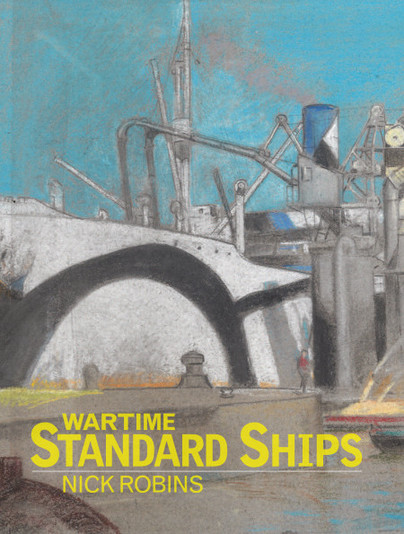
Wartime Standard Ships. By Nick Robins. Seaforth Publishing, Barnsley, 2017.
Reviewed by Tim Coyle
AS the name implies this book examines merchant ships constructed to standardised designs to meet the exponential demands for wartime sea transportation and to replace losses. British and US designs comprise most of the book’s coverage; however, German and Japanese wartime projects also receive attention.
Any mention of wartime standard ships brings the famous US designed and built Liberty ships to mind of which over 2700 were constructed. The later improved Victory ships, together with the C2 freighters and T2 tankers, demonstrated the enormous US production capability which greatly contributed to victory in World War 2. So adaptable were the US designs that many were taken into naval service as amphibious attack transports, stores ships and underway replenishment tankers. Prefabrication and welding, undertaken by semi-skilled workforces in ‘greenfield’ shipyards, turning out huge numbers of ships was not only a war winning formula but was the future of maritime trade. Hundreds of these vessels formed the core of the post-war merchant fleets, many remaining in service under various flags well into the 1960s.
The standard ships concept originated in World War One with the depredations caused by the German U-boat campaign. British shipowners not only decried the losses but also the Admiralty’s intransigence in allocating shipbuilding capacity to warship construction. The matter came to a head in summer 1916 when shipping executives established a number of greenfield sites to construct agreed common designs. By 1917 bureaucratic wrangling finally led to a program to construct four classes of standardised dry cargo ships. Production peaked in 1918 with 120 hulls, dropping to 110 in post-war 1919 and progressively declining to the program conclusion in 1921. As was to be the case post World War Two, the British wartime shipping program provided sound and economical ships for world trade in the 1920s and 30s and into the 1940s.
The US and Canadian shipbuilding expanded exponentially in World War One from a low base. By 1918 the US became the leading shipbuilding nation, both in terms of technology and output. The British Shipbuilding Controller placed orders in US yards in December 1916 for standard designs. However, each yard had its own concepts of what constituted a standard design and the variety of these ships are fully detailed in the book, supported by numerous photographs providing the reader with a comprehensive visual and textual understanding of the solutions to the massive Allied emergency building program.
While the book concentrates on the ship designs there are several well-known, but nevertheless dramatic, photographs depicting shipyard production in the vast World War Two US shipyards. Most of the shipyard workers performed monotonous production line duties. This led to absenteeism and a photograph in the book shows a stark condemnation to the temptation to take an unauthorised day off. A large billboard headed ‘Absentees Sabotage Ships’ states absentees constitute an ‘Axis Pay-Off Department’ castigating recalcitrants with details such as ‘Absentees have lost 514446 hours’ and ‘375000 hours build one ship’.
Merchant mariners enjoyed a relatively high standard of habitability in the US-built ships, not the least of which was the centralised accommodation for all hands in the central superstructure as opposed to the traditional separation of officers and crew, the latter normally banished to an after deckhouse. However, some 30 percent of Liberty ships suffered structural deficiencies due to sagging of the hull at mid-length caused by the cooling and contraction of the welded metal, mainly in the upper deck. Sub-standard steel, inexperienced workers and extreme cold added to the weaknesses which manifested themselves around hatchways and deck edges. Rectification through strengthening saw these ships rejuvenated to continue in service for many years.
The book concludes with an analysis of the influence of standard ship design on naval architecture. Wartime Standard Ships is a fine technical historical treatise on the ships that carried the war effort in the two major 20th century conflicts and seamlessly transitioned to the post-war merchant fleets that contributed to post-war rebuilding and development of the world economy. The many illustrations provide nostalgic views of the ships to those who can remember the pre-container era.
One Liberty and two Victory ships are preserved as operating museums. The Liberty Jerimiah O’Brien operates from San Francisco and Victories Lane Victory and American Victory sail from San Pedro and Tampa respectively on bi-annual short cruises in local waters.



